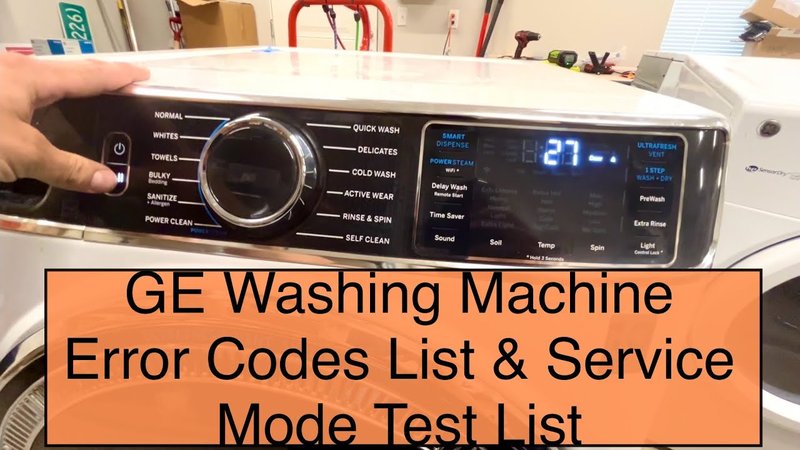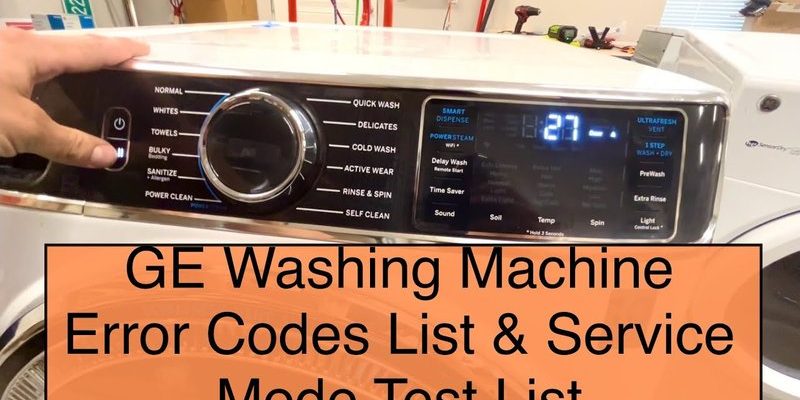
When your GE washing machine throws an “OE” error, it’s signaling that there’s an issue with the machine’s draining process. Essentially, your washer is having trouble emptying the water from the drum, similar to how a bathtub might struggle to drain if the plug is stuck. This drainage hiccup can stem from a variety of causes, all of which are typically manageable with a little patience and know-how. Ready to dive in and learn more about what could be causing this problem and how you can fix it? Let’s get started.
Understanding the OE Error Code
When your washing machine displays the OE error code, it’s like a red flag that something’s amiss in the draining department. Imagine your washing machine as a small ecosystem, with each part playing a crucial role in keeping your clothes clean. In this scenario, think of the drainage system as the system’s plumbing. When the flow isn’t quite right, things can get backed up, causing the machine to alert you with the OE error.
The OE code specifically points to an overflow error. In simpler terms, the machine is detecting that there’s too much water in the drum and it’s not draining away properly. While this might sound alarming, it’s usually not indicative of a severe problem. Common culprits include clogs in the hose or even a kink that’s preventing water from making its way out. It might also be due to a faulty pump, which is like trying to pour water from a jug with a blocked spout.
You might be wondering how serious this is. Fortunately, in most cases, the OE error is more of a bump in the road rather than a dead end. By understanding the potential underlying issues, you can tackle the problem head-on and get your machine up and running smoothly again.
Common Causes of the OE Error Code
One of the most frequent causes of the OE error is a clogged drain hose. Think about when you’re trying to drink from a straw that’s blocked—nothing gets through no matter how hard you try. Similarly, your washing machine can’t efficiently drain if the hose is obstructed. Debris, lint, or even small articles of clothing like socks can sneak into the hose, causing a blockage.
Another potential issue is a malfunctioning drain pump. This pump is essential for moving water out of the drum. If it’s not working, the water remains stagnant, and your machine lets you know through the OE code. Imagine trying to drive a car with a hole in the gas tank—no matter how much fuel you add, it won’t run properly until the leak is fixed.
Additionally, the problem might be simpler, like a kinked drain hose. Just as a kinked garden hose struggles to water your plants, a bent or pinched hose in your washing machine can’t drain water effectively. Always check to ensure the hose is straight and unobstructed.
Now that you know what might be causing the error, let’s talk about what you can do to fix it and some preventative measures you can take to avoid future troubles.
Steps to Resolve the OE Error Code
Ready to play detective and tackle this pesky error code? Let’s walk through some straightforward steps to resolve it. First, take a deep breath and unplug your washing machine. This will ensure safety as you investigate further. Safety first, right?
Start by examining the drain hose. Carefully detach it and inspect for any visible blockages. If you find any debris, clear it out. You may need a flashlight to look deeper into the hose. Reconnect the hose securely, making sure there are no kinks or bends—think of it as a gentle massage to keep the water flowing smoothly.
Next, check out the drain pump and filter. Locate the pump—usually at the bottom front of the machine—and remove the filter. You might find things you thought were long lost, like coins or buttons. Clean out any gunk or debris and reassemble everything. If the pump itself seems damaged or unresponsive, it might be time to call a professional for a replacement.
After you’ve given everything a good check, plug the machine back in and run a small-load wash to see if the problem persists. If the OE code is gone, give yourself a pat on the back—you did it!
Preventing Future OE Errors
Now that you’ve solved the mystery, let’s talk prevention. To keep this error at bay, regular maintenance is key. Consider doing a monthly check-up where you inspect hoses, clean filters, and ensure all parts are in tip-top shape. It’s like taking your washing machine in for a mini-tune-up.
Being mindful of what goes into your washer can also help. Avoid overloading it with clothes, as this can stress the drainage system. And remember to empty pockets before tossing clothes in—a simple coin can cause a large blockage.
Finally, using the right amount of detergent can prevent buildup in hoses and pumps. Too much soap is like trying to brush your teeth with a whole tube of toothpaste—more isn’t always better.
With these tips in your back pocket, you’re all set to tackle and prevent OE errors like a pro. Remember, maintenance is your machine’s best friend, and a little attention goes a long way in ensuring a long, trouble-free life for your GE washer.
